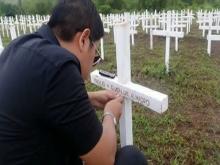Two Years After The Storm

Survivors look back on Haiyan with tears, gratitude and sadness “I hate this.” “I hate this feeling of hate and melancholy. Anger. Sadness. Loss. Sifting through old pics, I couldn’t help but cry, no, actually bawl. It’ll be two years since we lost you, but it seems like yesterday we were so happy, we were complete.” Aaron Almadro, a Typhoon Haiyan survivor from Palo in Leyte province, did not wax poetic as he logged on to his Facebook account and posted this message two days before Filipinos observed their annual tradition of flocking to the cemeteries on Nov. 1 — All Saints’ Day, which also marked a day of painful recollection of those who lost family members or friends to Typhoon Haiyan on Nov. 8, 2013. The storm surge brought by Haiyan killed more than 7,500 people, mostly from coastal areas in Tacloban, Palo and other nearby towns in the province.
“People around the world, even here in the Philippines, may have forgotten what happened, but the emptiness in this survivor’s heart will always remember that day — when everything changed,” said Almadro, as he recalled the loss of his parents to Haiyan. When Almadro lost his parents, he had also found another reason to live — his wife whom he married in May. To commemorate the second year since the tragedy, Almadro and his wife Daisy visited the public cemetery at Basper in Tacloban City — where the original mass burial site of Haiyan victims is found — before heading to the mass grave in Holy Cross Memorial Garden in the same village, and stopping at a hotel in Tacloban city, where Almadro’s parents stayed before a powerful storm surge hit their building. “For me the storm made us realize some things like … while many left, a number also came back to take care of the motherland … there was a lot of duality that came forth,” said Jerby Santo, 44, a budding musician from Tacloban who works for an international aid organization in the city.
“The loss and the need to create something new, the self-centered survival instincts that kicked in and the collective initiatives that eventually took over and ushered the revivalism of communities,” he said. “I was not here. I came back within a month after the storm. I kept coming back after December and then finally decided to come back here. You know when people talk, they say you were not here … like one is guilty because he was not here when it happened. And you know what, it is true,” he told ucanews.com. “Many of us who were not here feel that we failed our friends and relatives and communities. It will always be at the back of our minds. But now I feel like the most important thing is that I came back in the dark times and helped in the reconstruction of the homeland.” Difficult life For Fae Cheska Esperas, 29, another survivor in Tacloban, life is still difficult two years after the storm. “I am not yet OK, even though physically and economically speaking I have recovered. I still can’t stand strong winds and heavy rains because they make me remember that dreadful day,” she said.
“But I survived that dreadful day. Each day I wake up serves as a daily reminder of my survival. So whenever I feel the fear and anxiety I tell myself to not look back and continue to hold my head up high,” she said. After the storm, she found a job with a humanitarian organization, Community and Family Services International, assisting the poor and displaced in Zamboanga City in Mindanao. While the local government and various groups commemorated the disaster, another Haiyan survivor in Palo said he dealt with the event by staying home with his family. “We will light a candle and say our prayers at home with my wife and two children. The day is very special to us. That day changed my whole life,” said Ernani Fernandez, 39, a teacher in Palo. Fernandez recalled how they were trapped during the storm and eventually left the town three days later aboard a military plane in Tacloban en route to Manila with his pregnant wife, who was due to give birth to their second child that week.
“I am thankful my baby is safe. She will turn two years old in the next few days,” Fernandez said. “Indeed, for me, Haiyan brought the worst and best experiences to us.” In a stroke of timely luck, Fernandez recently was selected one of the top 10 educators in the Philippines, earning a US$10,500 award that he used to rebuild his home. Slow reconstruction Meanwhile, People Surge, a broad coalition of storm survivors in Tacloban, launched their “Global Day of Rage against Neglect and Impunity,” which culminated Nov. 8. The group has assailed what they describe as the government’s snail-paced construction of new homes and its lack of livelihood support. “The disaster survivors’ testimonies are real. We speak from our concrete experiences at the grassroots,” said Marissa Cabaljao, the group’s spokeswoman.
The group noted that only 534 permanent houses have been built out of a target of 13,801 houses. On Nov. 7, the city government of Tacloban unveiled two memorial markers in the coastal district of Anibong, where a large ship was washed ashore, and in the Astrodome center, which was used as one of the evacuation centers during Haiyan. On Nov. 8, the Catholic Church led in the lighting of 50,000 candles from Tolosa to Tacloban city in “collective remembrance and prayers” for the victims, said Msgr. Alex Opiniano of St. Michael the Archangel parish in Tolosa, Leyte. This article first appeared in UCA News-Bangkok, November 9, 2015 by the same author.
END


